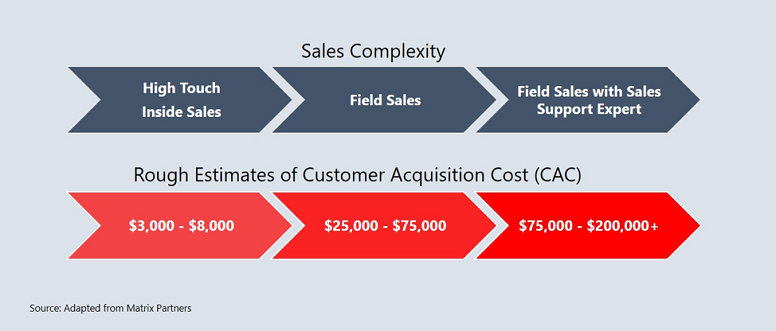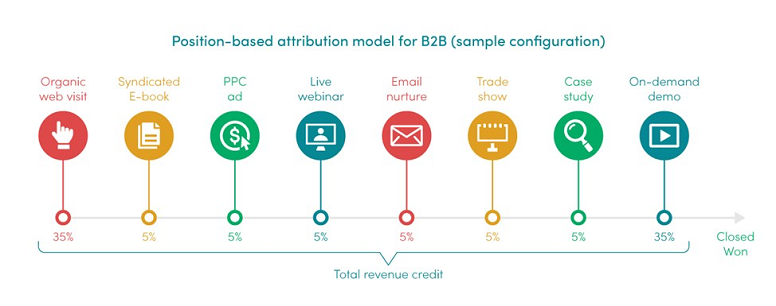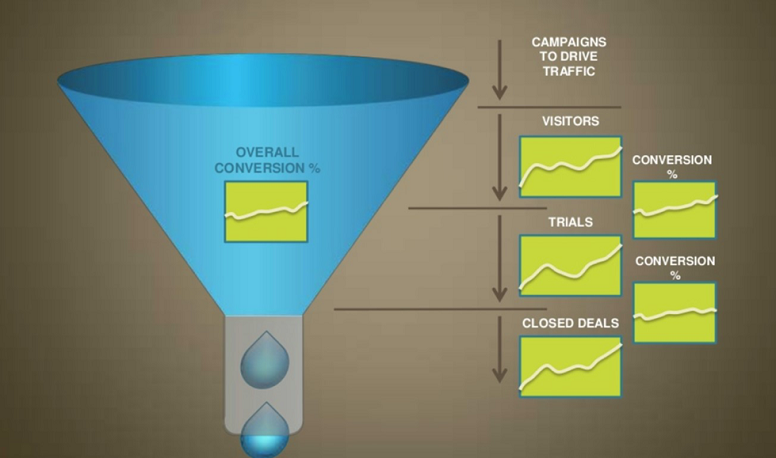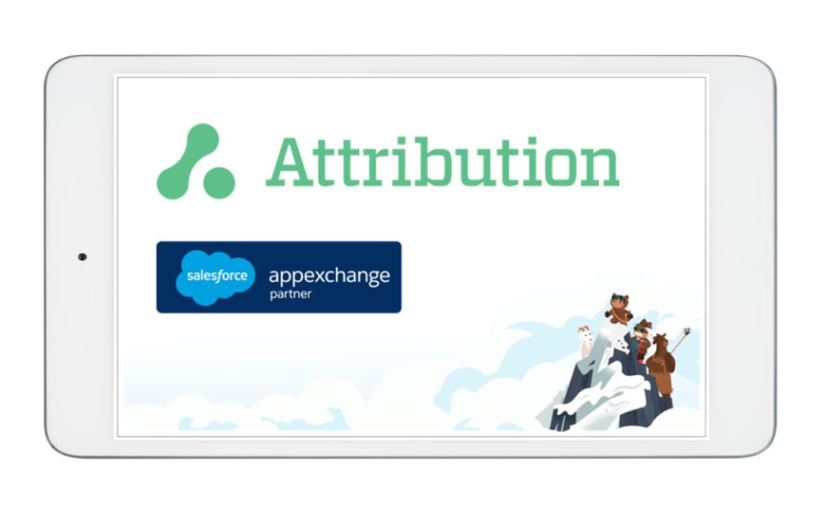B2B Marketing “Takes a Village”
Most B2B marketers would agree that acquiring new customers “takes a village” (marketing and sales) – it takes e-books, SEO, PPC ads, field events, blogs, retargeting ads, conferences, email nurtures, SDRs, case studies, free trials, 3rd party reviews, live chats, mailers, demos, webinars, and more, all working together to nudge buyers (and accounts) along a nonlinear journey, often starting with a Google search and progressing through various stages of the proverbial Salesforce funnel where concrete terms like MQLs, SALs, early and late stage pipe, and closed/won can be shared with marketers, sales folks, and board members. And the effort to acquire a single customer can be costly, easily reaching several hundred thousand dollars depending on the sales complexity and size of the prize. Hence, the better the village operates, the lower the customer acquisition cost (CAC), the higher the win rate and velocity, and the greater the valuation of a company (see our guide on CAC benchmarks for more on how to judge the right amount of spend on acquisition)

But the problem is most B2B marketers are painfully handicapped by an archaic single-touch (or source) attribution model, which typically culls marketing touches from a marketing automation platform (MAP) and attaches one touch to each opportunity in Salesforce – typically the first or last touch. Regardless of how influential the other touches were in nudging the buyer along, the first or last touch gets all the credit. Seriously!? How do you know which marketing touches or channels are really generating revenue? Adding to this heap of attribution chaos is the length and complexity of the B2B journey, which often involves multiple contacts and can take months to over a year to close. How do you know which marketing touches are delivering the best outcomes by funnel stages such as MQLs created or Opportunities generated?
Multi-Touch Attribution for Salesforce is Here with Attribution’s Salesforce Integration
That’s why we’re excited to announce that Attribution for Salesforce integration is now available on Salesforce AppExchange, giving Salesforce customers an easy path to start their multi-touch attribution journey.
With Attribution’s Salesforce integration, Salesforce customers get easy access to a multi-touch attribution SaaS platform that automatically:
- Connects their lead and deal stages in Salesforce to the entire cast of marketing touches including on and offline channels and campaigns.
- Accesses revenue data from Salesforce for a complete return on ad spend (ROAS)
Our multi-touch attribution platform is architected from the ground up to simplify the complexity of B2B marketing attribution through:
- Highly configurable time decay, linear, position-based and custom machine learning multi-touch attribution models
- A patent pending cohort method to precisely allocate credit for revenue, conversions, and cost for any touch, channel, and/or account-based marketing effort
- Pre-integration with all major B2B adtech and martech platforms including LinkedIn, HubSpot, Facebook Ads and Google Ads, as well as any tracking parameter
- Built-in auditing engine that reconciles revenue credits, preempting giving credit to channels/campaigns that had no role in the conversion to revenue.
Turbocharge Full-Funnel Demand Generation and Account-Based Marketing
There are hundreds of ways B2B marketers can spend their budgets and resources.
Do I spend it on thought leadership webinars or blogs to drive top-of-funnel metrics like traffic, social followers, and site time, or do I increase mid-funnel tactics like e-books, retargeting ads, webinars or conferences to grow click-throughs and MQLs? Or maybe I go all in on down-funnel things like nurture campaigns, direct mail, review sites, or field marketing events to drive new opportunities or accelerate pipeline stages?
How should I allocate my budget by channel, content, and/or campaign? Do I plan a frontal assault with LinkedIn ABM campaigns and retreat with Google retargeting? How much should I invest (or not) in BrightTALK, G2 Crowd, trade shows, field seminars, TechTarget content promotion, social media, direct mail, SEO, webinars and/or e-books?
For B2B marketers, the data analysis can be dizzying. And unless there’s a silver bullet awaiting, marketers must prioritize (continuously) which ones to invest in, which ones to watch, and which ones to stop.
Unlike single-touch / channel attribution, multi-touch or multi-channel attribution is touch-neutral. Regardless of source, it follows the money of each touch, allocates revenue and costs, and determines true ROI. Multi-touch attribution informs B2B marketers which channels and campaigns to place their bets across the marketing mix and which ones to avoid. Since our multi-touch software is integrated to Salesforce, it automatically connects upper-funnel activities (keyword clicks, ad campaigns, blog articles, webinars, emails, etc.) to lower-funnel results (opportunity conversions, closed deals, and revenue generated).

With Attribution’s Salesforce integration, Salesforce customers can easily compare granular attribution data at the touchpoint level. MQLs, opps, pipe, and/or revenue can be attributed directly to specific keywords, online ads, events, and other channels or campaigns. By examining the down-funnel conversion rates of leads generated in earlier funnel stages, marketers have can better optimize their budgets and activities. If marketers know the opportunity-conversion rates of leads generated by a given channel or campaign, they can make decisions about how to reuse or improve those activities in the future. B2B marketers can easily compare campaigns against each other based on their respective down-funnel results (opportunities, customers, and revenue).
Marketers can use the insights from multi-touch attribution to make the right decision throughout the entire demand generation funnel from initial touch to MQL to pipe to booking and scale their spending up or down accordingly.
Align Sales and Marketing at a Whole New Level

By connecting Salesforce conversion data to our multi-touch attribution platform, marketing and sales can leverage insights from full-funnel attribution to confidently align at a whole new level and continuously improve efficacy in each stage of the funnel. What exactly does this mean? The actionable insights marketers from multi-touch attribution can increase sales productivity. I’ll say it again, by optimizing all stages of the marketing funnel to revenue, sales people will increase opportunity conversion, deal velocity, and overall win rate. Together, Salesforce and multi-touch attribution do this this by:
- Tracking a leads journey and quality from first-touch through the marketing and sales funnel to closed / won, giving salespeople powerful nuggets intelligence of what the buyer has interacted with throughout their journey.
- Tracking every marketing touchpoint in a given account, from every social click to every content download to booth visit, a sales person knows precisely how the lead has progressed through the funnel at any given time.
- Streamlining the lead handoff between marketing and sales with revenue data being tracked to marketing campaigns in Salesforce, providing a lead’s ‘story’ and enabling more impactful sales outreach.
- Enabling collaborative, data-driven forecasting between sales and marketing, eliminating the guesswork of what marketing budget will produce which outcome in terms of pipeline and revenue.
- Unifying sales and marketing investments around trade shows and conferences (often one of the largest budget lines) through attribution insight how a given event and related sales activities at the event like seminars and dinners worked.
By providing both sales and marketing with a single-source of attribution truth aligned to pipe and revenue, marketing and sales teams can rally around one playbook to optimize CAC and maximize revenue.
Build a Customized Multi-Touch Attribution Model
According to Chief Marketer’s Attribution Still a Huge Challenge for B2B Marketers report, “lengthy sales cycles, numerous touchpoints and too much data are among the biggest hurdles B2B marketers face when it comes to accurate attribution.” B2B marketers are dealing with a plethora of content platforms and marketing channels with multiple sources of leads over a long timeline, so easily and quickly telling the full attribution story, including what influenced the deal, and justifying events, ads and other investments is hard when you look at first and last touch only.

Adding Attribution for Salesforce frees B2B marketers from single-touch jail and enables them to easily see the full and true attribution story, which touchpoints are really working, which ones need monitoring, and which ones need to go.
Attribution’s Salesforce integration is currently available on the AppExchange here.
To learn more about Attribution’s Salesforce integration, click here.
